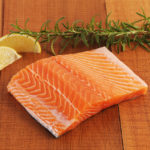
Some types of fish are rich in omega-3, a polyunsaturated fatty acid (PUFA) with reported health benefits by some studies, like reduction of cancer risk and protection from heart disease.
All fish contain omega-3 but the quantity of it varies greatly between different types. In general, omega-3 rich fish meet two conditions:
- They live in cold water
- Their diet promotes the production of omega-3
Because these fish live in deep cold water in the oceans, they need to store more fat that serves them as insulation from the low temperatures of this environment. Also, the algae consumers are the best source of omega-3 because algae have a high content of DHA, which is a type of omega-3.
As well as obtaining omega-3 from the diet, it can be produced by our metabolism. More precisely, there is one omega-3 fatty acid, called α-linolenic acid (ALA), that we cannot synthesize and therefore we need to incorporate it through the diet. For this reason, we refer to it as an “essential fatty acid”. Two other omega-3 fatty acids can be obtained through the metabolism of ALA. These are eicosapentaenoic acid (EPA) and docosahexaenoic acid (DHA). Conversion of ALA into EPA and DHA, however, is not very efficient and for this reason it is better to obtain EPA and DHA from the diet.
Sources of omega-3
As mentioned above, cold water oily fish are rich in omega-3 but also some plants have a high content of this PUFA. In particular, good sources of ALA are green leafy vegetables, flax and chia seeds, walnuts, walnut oil and soybean oil. Oily fish, algae oil and krill oil are rich in EPA and DHA.
The following table shows some examples of oily fish and their omega-3 content:
| Type of fish | Omega-3/100 grams |
| Mackerel | 2.6 |
| Trout, lake | 2.0 |
| Herring | 1.7 |
| Tuna, bluefin | 1.6 |
| Salmon | 1.5 |
| Sardines, canned | 1.5 |
| Sturgeon, Atlantic | 1.5 |
| Tuna, albacore | 1.5 |
| Whitefish, lake | 1.5 |
| Anchovies | 1.4 |
| Bluefish | 1.2 |
| Bass, striped | 0.8 |
| Trout, brook | 0.6 |
| Trout, rainbow | 0.6 |
| Halibut, Pacific | 0.5 |
| Pollock | 0.5 |
| Shark | 0.5 |
| Sturgeon | 0.4 |
| Bass, fresh water | 0.3 |
| Catfish | 0.3 |
| Ocean perch | 0.3 |
| Flounder | 0.2 |
| Haddock | 0.2 |
| Snapper, red | 0.2 |
| Swordfish | 0.2 |
| Sole | 0.1 |
Omega-3 and the gut microbiota
Currently, studies on the interaction between dietary omega-3 and gut microbiota are scarce. Nevertheless, a few observations have been made.
The first thing to consider is that there are no bacteria in the human gut that can produce omega-3. Some bacteria living in the colon, however, can metabolise omega-3. The products that result from this conversion are called conjugate linolenic acids. This means that they influence how much omega-3 remains for us. In addition, some research has found that conjugated linolenic acids may protect from cancer and obesity.